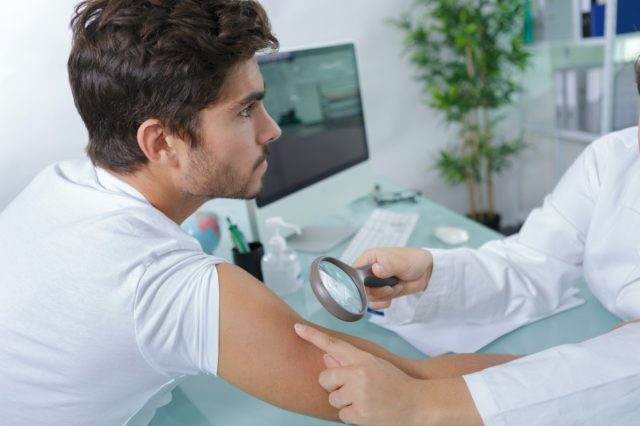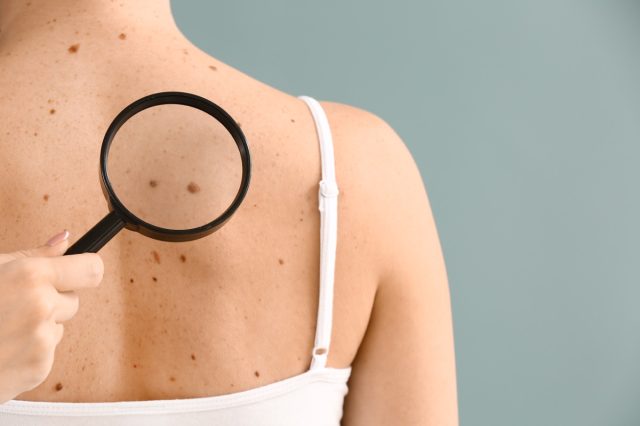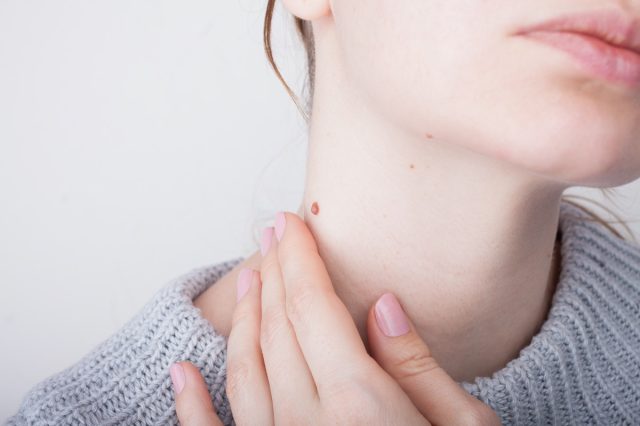Skin cancer is the most common type of cancer in the United States and there are three major types: basal cell carcinoma, squamous cell carcinoma and melanoma, which is the most serious. The American Cancer Society states, "Cancer of the skin is by far the most common of all cancers. Melanoma accounts for only about 1% of skin cancers but causes a large majority of skin cancer deaths." This year alone the ACS estimates, "About 99,780 new melanomas will be diagnosed (about 57,180 in men and 42,600 in women). About 7,650 people are expected to die of melanoma (about 5,080 men and 2,570 women)." Like with any cancer, knowing the symptoms and early detection is key. Eat This, Not That! Health spoke with experts who share what to know about melanoma and signs you have it. As always, please consult your physician for medical advice.
What to Know About Melanoma

Brian R. Toy, M.D., board-certified dermatologist with Providence Mission Hospital tells us, "Melanoma is the deadliest form of skin cancer. Some individuals have a genetic predisposition for developing it, but in many cases, melanoma can be caused by excessive lifetime exposure to the sun as well as blistering sunburns during childhood."
Viktoryia Kazlouskaya, a board certified dermatologist with Khrom Dermatology adds, "Sun exposure, fair skin, history of tanning bed use may contribute to the higher chance of getting melanoma. Melanoma can happen at any age but is relatively rare in kids."
How Treatable is Melanoma?

According to Dr. Toy, "Early-stage melanoma is treated by surgery alone. Melanoma that has spread to the lymph nodes or vital organs (called metastatic melanoma) is commonly treated by immunotherapy, whereby antibodies are injected intravenously into the bloodstream to attack the cancerous cells."
Dr. Kazlouskaya explains, "Melanoma is classified based on how thick it is (which is measured under microscope after the skin sample is taken), and if it involves lymph nodes or other organs. When melanoma is early (usually less than 0.8mm of thickness) it is treatable with surgery alone. In more advanced cases, more aggressive therapy may be needed."
Dr. Nadir Qazi, DO, a board-certified physician, cosmetic dermatology surgeon, and owner of Qazi Cosmetic Clinic tells us, "Melanoma in its early stages is incredibly treatable these days, with a five-year survival rate of 99% in the first stage. However, in later stages, it becomes more challenging to treat and more challenging for the patient to recover, with the five-year survival rate dropping to 30%. Skin cancer treatments vary from chemotherapy and topical chemo creams to surgery and skin grafting. It's important for every person, regardless of skin color, see a dermatologist at least once a year for a complete skin check, but don't wait for a planned appointment should any anomalies in your skin be noted through self-exams. It is false that people with darker skin don't get skin cancer. Everyone is susceptible."
How to Help Prevent Melanoma

Dr. Toy says, "Melanoma is best prevented by judicious use of sunscreen and sun-protective clothing, including hats and sunglasses. Tanning is never a good idea, as it increases your risk of skin cancer and causes premature aging such as wrinkles and sunspots."
Dr. Orit Markowitz, dermatologist, skin cancer specialist, and CEO and Founder of Markowitz Medical tells us "Most of us are familiar with the notion of protecting ourselves from the sun with the use of sunscreen and protective clothing. While that's incredibly important in preventing the development of melanoma, preventing advanced-stage melanoma is imperative, as well. Early detection is the key to surviving melanoma, so you should take part in regular skin checks, both at home and annually by a doctor, to ensure any suspicious moles are properly analyzed and removed before melanoma can spread throughout the body. Although melanomas most often develop in areas that are exposed to the sun, they can develop anywhere on the body, so be sure to include all parts of your body in self-conducted and annual skin checks."
Remember Your ABC's

Dr. Toy explains, "Melanoma typically presents as an unusual mole that changes over time in size, shape, or color. I instruct my patients to look for the ABCDEs:
A – asymmetry (odd shape)
B – border (irregular contours)
C – color (color variation)
D – diameter (anything larger than a pencil eraser)
E – evolution (anything that changes in appearance over time)"
Skin Discoloration

Dr. Qazi states, "Not all melanomas are dark; they can be amelanotic, lacking pigment and presenting as pinkish, purple, or even colorless. This type of melanoma can be more challenging to detect and can be misdiagnosed as benign. It is so important to check your skin frequently for any changes following the ABCDEs. Watch for moles that are colorless, colorful, and deep dark brown or black. Melanomas (dark or light), may also appear in spots that don't regularly see sunlight, such as the palms or the bottoms of the feet. It doesn't necessarily follow the pattern of exposure to the sun."
Streaks in Nail Beds

According to Dr. Qazi, "Brown striping on nailbeds is an indication of subungual melanoma. It isn't a common disease, and it is one of the more dangerous types of melanoma, so early detection is critical. If the striping is pink or purple, it could also be amelanotic and should still be checked by a trained medical professional."
A Mole that is Crusting, Bleeding and Not Healing

Dr. Markowitz says, "One of the most aggressive types of melanoma is amelanotic melanoma. This is often harder to identify because it doesn't produce the pigment melanin, which gives most melanomas a darker appearance. Instead, amelanotic melanomas are known to be pink, crusty and often peeling."
A New Mole or Lesion Should Always Be Checked

Dr. Markowitz shares, "With the tools available to practitioners now, even the smallest and tiniest dark spots can be identified and diagnosed at the earliest and most preventative stages. It's best to have any new moles analyzed by a professional at your annual skin check to ensure that if action does need to be taken, it can be done sooner rather than later."
Find a Trusted Dermatologist

Dr. Toy states, "Patients who are diagnosed with melanoma should be managed by a board-certified dermatologist. The dermatologist will perform outpatient surgery under local anesthesia if it is an early-stage melanoma. More advanced melanoma will be referred to a surgical oncologist, as lymph nodes will need to be sampled under general anesthesia. If the melanoma has spread to the lymph nodes, the patient will be additionally referred to a medical oncologist for immunotherapy and potentially chemotherapy. In any case, the dermatologist should be the main point of contact who will coordinate care among the different specialties."
No comments:
Post a Comment